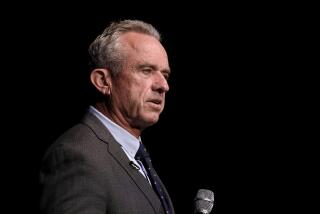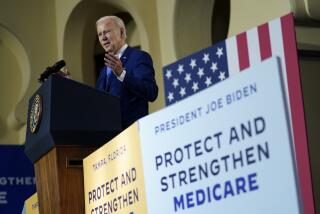Mock News on Medicare Called Illegal
- Share via
WASHINGTON — Mock news reports produced and distributed to local television stations by the Bush administration to promote the Medicare prescription drug program violated a provision of federal law that prohibits the use of taxpayer funds for “covert propaganda,” the General Accounting Office determined Wednesday.
The GAO, the investigative arm of Congress, noted that the administration had labeled its entire “video news release” package so that the 126 television stations receiving it would know that it came from the Centers for Medicare and Medicaid Services and its parent agency, the Department of Health and Human Services.
But that fact was not apparent to the 41 million senior and disabled Medicare beneficiaries who were the target audience of the “purported news story,” which included the voices of off-camera production company employees identifying themselves as Washington reporters, the GAO said in a decision signed by General Counsel Anthony H. Gamboa.
“Nothing in the story packages permit the viewer to know that Karen Ryan and Alberto Garcia were paid with federal funds through a contractor to report the message in the story package,” the agency said. “The entire story package was developed with appropriated funds but appears to be an independent news story.”
Ryan was the “reporter” for the English-language stories and Garcia for the Spanish-language version.
The GAO also found that the department had violated a second law, the Antideficiency Act, against using federal money for unauthorized purposes. Since “covert propaganda” is illegal, the GAO said, there were no funds authorized to produce it. The packages cost $43,000 to make.
According to the GAO, that law requires agencies that violate it to report their actions to the president and Congress. But Bill Pierce, spokesman for the Department of Health and Human Services, indicated that although top department officials were still reading the 16-page decision, it was unlikely the administration would comply.
“GAO opinions are not binding on the executive branch,” he said. “This is the opinion of the GAO. We disagree with that opinion.”
He also said it was the responsibility of the television stations’ editors and producers to inform viewers of the source of the material.
“This was in no way covert, as they claim,” Pierce said. “This was overt, in every way.... We provided them with every technological ability to tell the audience who it was from,” he said.
Asked if he could understand that a viewer might be angry about not being informed of the source of the mock news story, Pierce said, “If I’m a viewer, I’d be angry at my television station.”
Forty television stations in 33 media markets, including Santa Barbara and Fresno, aired all or part of the Medicare video package at least 53 times in January and February, said Health and Human Services Department officials.
The GAO decision was awkward for the administration, which has been promoting the new Medicare discount drug card in the face of complaints from seniors and consumer advocates that the program is confusing and offers only limited savings.
Minutes before the GAO released to the media its decision on the Medicare video package, the Centers for Medicare and Medicaid Services issued a report that low-income Medicare beneficiaries could save between 29% and 77% on brand-name prescription drugs. The agency later announced that it had taken action to improve access to its toll-free information line and its website.
The GAO finding also gave Democrats another opening to critique how the administration shaped and promoted the Medicare reform law, which Republicans had believed would help them gain support among older voters in this fall’s elections.
In January, the administration revealed that its final cost estimate for the law was $534 billion over 10 years, one-third more than the $400-billion maximum it told Congress to provide.
Medicare’s top financial analyst said later that the then-Medicare administrator had threatened to fire him if he shared his cost estimates with Democratic lawmakers. The Congressional Research Service said recently that the administration’s withholding of the cost estimates probably violated federal law. The administration refuses to release its complete cost analysis to Democratic lawmakers, and this week 19 House Democrats filed suit to force the disclosure.
“The new GAO opinion is yet another indictment of the deception and dishonesty that has become business as usual for the Bush administration,” said Sen. Edward M. Kennedy (D-Mass.). “It was bad enough to conceal the cost of the Medicare drug bill from the Congress and the American people. It is worse to use Medicare funds for illegal propaganda to try to turn this lemon of a bill into lemonade for the Bush campaign.”
This year, several Democratic senators asked the GAO to investigate whether the administration’s commercials and fliers promoting Medicare constituted illegal propaganda. The GAO concluded that although those materials contained “notable omissions and errors,” they were technically legal. It was in that investigation that GAO officials discovered the administration’s “video news releases,” which had not previously been disclosed.
The head of the GAO, Comptroller General David M. Walker, then made the decision to determine whether the Medicare video packages were legal.
“We evaluated all of the reasons that [administration officials] thought it wasn’t covert, but what we saw was something that was running that the viewer had no idea was put together by [the Centers for Medicare and Medicaid Services]. That’s the reason it was covert,” said Susan Poling, a managing associate general counsel at the GAO.
More to Read
Sign up for Essential California
The most important California stories and recommendations in your inbox every morning.
You may occasionally receive promotional content from the Los Angeles Times.










